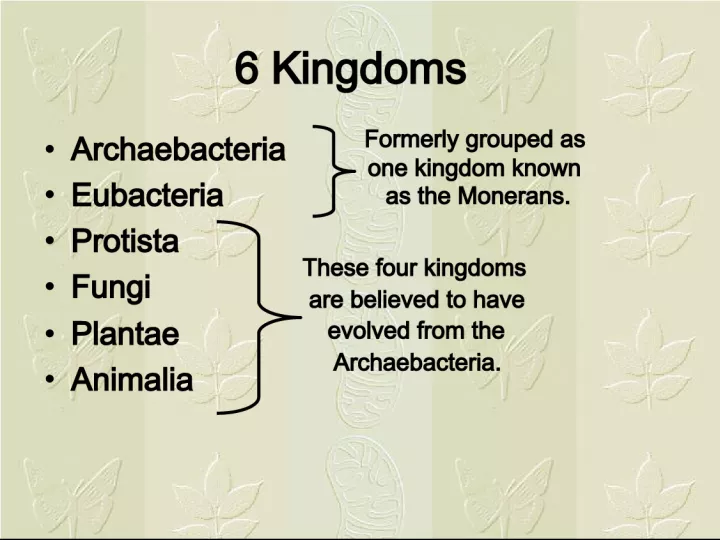The Four Kingdoms of Life's Evolution


Archaebacteria, Eubacteria, Protista, Fungi, Plantae, and Animalia kingdoms are thought to have evolved from a common ancestor billions of years ago.
- Uploaded on | 2 Views
-
 theapoulsen
theapoulsen
About The Four Kingdoms of Life's Evolution
PowerPoint presentation about 'The Four Kingdoms of Life's Evolution'. This presentation describes the topic on Archaebacteria, Eubacteria, Protista, Fungi, Plantae, and Animalia kingdoms are thought to have evolved from a common ancestor billions of years ago.. The key topics included in this slideshow are . Download this presentation absolutely free.
Presentation Transcript
2. 6 Kingdoms • Archaebacteria • Eubacteria • Protista • Fungi • Plantae • Animalia These four kingdoms are believed to have evolved from the Archaebacteria. Formerly grouped as one kingdom known as the Monerans.
3. Cell Types Prokaryotes Eukaryotes • No nucleus • No membrane-bound organelles • Found only in Archaebacteria and Eubacteria Kingdoms • Has nucleus • Many organelles • Includes Protista, Fungi, Plantae and Animalia Kingdoms
4. Types of Nutrition • Autotrophs : (able to make own food) 1.) Photosynthetic -organism that uses energy from the sun to make its own food 2.) Chemosynthetic -simple nonliving chemical nutrients such as H 2 S, sulfur, and iron are consumed and made into living tissue; makes its own food • Heterotrophs : (unable to make own food) 1.) Ingestion : organism eats other organisms or their organic byproducts 2.) Absorption : produces enzymes that break down food particles outside the body, then absorb the digested molecules
5. Kingdom Archaebacteria • Cell Type : prokaryotes (original life form on earth; gave rise to eukaryotes) • Body Forms : unicellular • Cell Structure : – Cell Wall – Genetic Material – NO Organelles • Nutrition : autotrophs or heterotrophs • Habitat : extreme environments such as deep sea volcanic vents, hot springs
6. Kingdom Archaebacteria Other Important Information: fewer than 100 species are believed to exist Sketches of Cellular Examples: Examples: methanic bacteria, halophile bacteria, anaerobic bacteria
7. Kingdom Eubacteria • Cell Type : Prokaryotes - considered the “true bacteria” • Body Forms : unicellular • Cell Structure : – Cell Wall – Genetic Material – NO Organelles • Nutrition : photosynthetic and chemosynthetic autotrophs; heterotrophic forms too • Habitat : Common environments – land, water and air; live in and on organisms
8. Kingdom Eubacteria Other Important Information: extremely diverse – more than 5000 species exist. Ecologically important as decomposers. Symbiotic relationships with humans – mutualistic in gut; parasitic when they cause disease. Sketches of Cellular Examples: Examples: Anthrax, E. coli, Salmonella, Gonorrhea
9. Kingdom Protista • Cell Type : Eukaryotes • Body Forms : mostly unicellular, some multicellular, some colonial • Cell Structure : – Cell Wall – Nucleus – Membrane-bound Organelles – Chloroplasts • Nutrition : photosynthetic autotrophs and heterotrophs that use ingestion or absorption • Habitat : freshwater and ocean water, in and on organisms
10. Kingdom Protista Other Important Information: the “catch-all kingdom”; range from microscopic to 150 feet long in size; some are animal-like, some are plant-like; some cause disease . Sketches of Cellular Examples: Examples: kelp, algae, slime mold, Paramecium, Amoeba, Euglena , diatoms
11. Kingdom Fungi • Cell Type : Eukaryotes • Body Forms : some unicellular, most multicellular • Cell Structure : – Cell Wall made of chitin – Nucleus (sometimes more then 1) – Organelles (no chloroplasts) – Opening between adjacent cells • Nutrition : heterotrophic (absorption) • Habitat : most are terrestrial, some live on or in organisms
12. Kingdom Fungi Other Important Information: Ecological importance as decomposers. Many have relationships with other organisms. In humans- parasitic fungus cause athlete’s foot and ringworm. Mutualistic examples too: mychorrizae in plants and lichens with algae. Sketches of Cellular Examples: Examples: bread mold, yeast, mushrooms, mildew, mold, truffles
13. Kingdom Plantae • Cell Type : Eukaryotes • Body Forms : multicellular • Cell Structure : – Nucleus – Organelles – Chloroplasts – Cell wall made of cellulose – Large Central Vacuoles • Nutrition : photosynthetic autotrophs • Habitat : mostly terrestrial
14. Kingdom Plantae Other Important Information: plants are the base of terrestrial food chains; more than 262,000 species exist Sketches of Cellular Examples: Examples: moss, ferns, pine trees, oak trees, shrubs, flowers, grass
15. Kingdom Animalia • Cell Type : Eukaryotes • Body Forms : multicellular • Cell Structure : – Nucleus – Organelles – NO chloroplast – NO cell wall • Nutrition : heterotrophic • Habitat : land, water, air
16. Kingdom Animalia Other Important Information: the most diverse of all kingdoms in appearance; most are motile (they can move) Sketches of Cellular Examples Examples: sponges, worms, snails, insects (ants, grasshoppers), birds, snake, fish, elephant, human